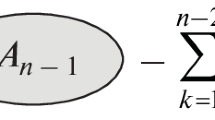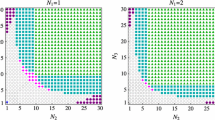Summary
We formulate a general theory of the strong-coupling limit of renormalizable interacting quantum fields. For definiteness, our ideas are explicitly illustrated in the case of the scalar field with quartic selfcoupling, the usual testing ground for new ideas in field theory. More precisely, the generating functional for connected Green’s functions is explicitly constructed for this latter theory in the limit of large coupling. The problem of regularization is treated in detail. For purposes of illustration, the first two orders in the large-coupling limit of the Fourier transform of the connected two-point function are computed. It is found that the Fourier transform for 4-momentump approaches its large-p 2 limit essentially exponentially. The applicability of our approach to all renormalizable theories is thereby made more manifest.
Riassunto
Si formula una teoria generale del limite di accoppiamento forte di campi quantistici interagenti rinormalizzabili. Per essere esatti, si illustrano esplicitamente le nostre idee nel caso del campo scalare con autoaccoppiamento quartico, il terreno di prova usuale per nuove idee nella teoria di campo. Più precisamente, si costruisce esplicitamente il funzionale generatore per funzioni di Green connesse, per quest’ultima teoria nel limite di accoppiamento grande. Si tratta in dettaglio il problema della regolarizzazione. Per chiarire, si calcolano i primi due ordini nel limite di accoppiamento grande della trasformazione di Fourier della funzione connessa a due punti. Si trova che la trasformazione di Fourier per il quadrimpulsop si avvicina in modo essenzialmente exponenziale al limite perp 2 grande. Si rende quindi più manifesta l’applicabilità del nostro approccio a tutte le teorie rinormalizzabili.
Реэюме
Мы формулируем обшую теорию предела сильной свяэи для перенормируемых вэаимодействуюших квантовых полей. Для определенности рассматривается случай скалярного поля с квадратичной собственной свяэью, что является обычной проверкой новых идей в теории поля. В пределе сильной свяэи конструируется проиэводяший функционал для функций Грина. Подробно рассматривается проблема регуляриэации. Для иллюстрации вычисляются первые два члена в пределе сильной свяэи для Фурье-преобраэования свяэанной двухточечной функции. Обнаружено, что Фурье-преобраэование для четырех-импульсаp стремится зкспоненциально к пределу больщихp 2. Отмечается применимость нащего подхода ко всем перенормируемым теориям.
Similar content being viewed by others
References
B. F. L. Ward: to appear.
R. P. Feynman:Rev. Mod. Phys.,20, 367 (1948);Phys. Rev.,74, 1430 (1948).
J. Schwinger:Phys. Rev.,74, 1439 (1948).
S. Tomonaga:Prog. Theor. Phys. (Kyoto),1, 27 (1946).
Our use of the word «small» in the proof of the claim in sect.2 requires some comment. For we do not simply mean that a term in ℒ is small if its coupling coefficient is small. Rather, we intend that, after rescaling the theory, one separates out the small operators from those which are large and thereby expands the respective functional in a meaningful way. In the example treated in sect.3, we expand the scalar field theory (3.4) in powers ofπ 2/8σ √g and integrate out the usual free Lagrangian terms completely, since — d4 x π 2/8σ √g would appear to bethe small part of the action in (3.4). In this way, we have departed from the formal approach ofHori, who attempted to formally expand the free Lagrangian terms against the interaction terms, a procedure which would appear suspect. We thankDr. U. Bar-Gadda for calling the work ofHori to our attention.S. Hori:Nucl. Phys.,30, 644 (1962).
G. ’t Hooft andM. Veltman:Nucl. Phys.,44 B, 189 (1972).
K. G. Wilson:Phys. Rev. D,6, 419 (1972).
G. Wentzel:Helv. Phys. Acta,13, 269 (1940);14, 633 (1941).
Author information
Authors and Affiliations
Additional information
Work supported by the U.S. Energy Research and Development Administration.
Rights and permissions
About this article
Cite this article
Ward, B.F.L. Strongly coupled fields. Nuov Cim A 45, 1–27 (1978). https://doi.org/10.1007/BF02729912
Received:
Published:
Issue Date:
DOI: https://doi.org/10.1007/BF02729912




